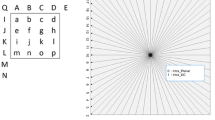Abstract
Context-based adaptive binary arithmetic coding (CABAC) is a single entropy coding mode of the newest video coding standard, High Efficiency Video Coding (HEVC). Despite the high coding efficiency of CABAC, its data dependencies prevent effective parallelization, which also means limited throughput. Accordingly, during the HEVC standardization activity of entropy coding, both coding efficiency and throughput were considered. This paper highlights the key techniques that were proposed and adopted up to HEVC Draft International Standard (DIS). In addition, a new method is proposed for high throughput entropy coding. This method reduces the worst-case complexity of entropy coding without significant coding efficiency loss. From the experimental results, in terms of throughput improvement, we confirm that the proposed method reduces the number of context-coded bins up to 42.1 and 15.9 % on average.










Similar content being viewed by others
References
Bross, B., Han, W., Ohm, J., Sullivan, G., & Wiegand, T. (2012). High Efficiency Video Coding (HEVC) text specification draft 8. ITU-T SG16 WP3 and ISO/IEC JTC1/SC29/WG11, Doc. JCTVC-J1003.
Sullivan, G., Topiwala, P., & Luthra. A. (2004). The H.264/AVC advanced video coding standard: overview and introduction to the fidelity range extensions. Proc. of SPIE conference, Special Session on Advances in the New Emerging Standard: H.264/AVC (pp. 454–474).
Marpe, D., Schwarz, H., & Wiegand, T. (2003). Context-based adaptive binary arithmetic coding in the H.264/AVC video compression standard. IEEE Transactions on Circuits and Systems for Video Technology (CSVT), 13(7), 620–636.
Sze, V. (2011). Context selection complexity in HEVC CABAC. ITU-T SG16 WP3 and ISO/IEC JTC1/SC29/WG11, Doc. JCTVC-D244.
Sze, V., & Budagavi, M. (2012). High throughput CABAC entropy coding in HEVC. IEEE Transactions on Circuits and Systems for Video Technology (CSVT), 22(12), 1778–1791.
Bjøntegaard, G., & Lillevold, K. (2002). Context-adaptive VLC (CVLC) coding of coefficients. ITU-T SG16 Q.6 and ISO/IEC JTC1/SC29/WG11, Doc. JVT-C028.
Sole, J., Joshi, R., & Karczewicz, M. (2011). CE11: Parallel context processing for the significance map in high coding efficiency. ITU-T SG16 WP3 and ISO/IEC JTC1/SC29/WG11, Doc. JCTVC-E338.
Nguyen, N., Ji, T., He, D., Martin-Cocher, G., & Song, L. (2011). Multi-level significant maps for large transform units. ITU-T SG16 WP3 and ISO/IEC JTC1/SC29/WG11, Doc. JCTVC-G644.
Nguyen, T., Marpe, D., Schwarz, H., & Wiegand, T. (2011). Reduced-complexity entropy coding of transform coefficient levels using truncated Golomb-Rice codes in video compression. Proc. of IEEE Int. Conf. on Image Processing (ICIP) (pp. 753–756).
Sze, V., & Chandrakasan, A. (2012). A highly parallel and scalable CABAC decoder for next generation video coding. IEEE Journal of Solid-State Circuits, 47(1), 8–22.
Chien, W., Sole, J., & Karczewicz, M. (2011). Last position coding for CABAC. ITU-T SG16 WP3 and ISO/IEC JTC1/SC29/WG11, Doc. JCTVC-G704.
Nguyen, T., Marpe, D., Siekmann, M., & Wiegand, T. (2012). Non-CE1: High throughput coding scheme with rice binarization. ITU-T SG16 WP3 and ISO/IEC JTC1/SC29/WG11, Doc. JCTVC-H0458.
Kim, S., Misra, K., Kerofsky, L., & Segall, A. (2012). Non-CE1: High Throughput Binarization (HTB) method with modified level coding. ITU-T SG16 WP3 and ISO/IEC JTC1/SC29/WG11, Doc. JCTVC-H0510.
Lainema, J., Ugur, K., & Hallapuro, A. (2012). CE1.D1: Nokia report on high throughput binarization. ITU-T SG16 WP3 and ISO/IEC JTC1/SC29/WG11, Doc. JCTVC-H0232.
Chen, J., Chien, W., Joshi, R., Sole, J., & Karczewicz, M. (2012). Non-CE1: Throughput improvement on CABAC coefficients level coding. ITU-T SG16 WP3 and ISO/IEC JTC1/SC29/WG11, Doc. JCTVC-H0554.
Karczewicz, M., Wang, X., & Chien, W. (2011). CE5: Improved coefficient coding with LCEC. ITU-T SG16 WP3 and ISO/IEC JTC1/SC29/WG11, Doc. JCTVC-D374.
Davies, T. (2011). CE1: Subtest 12, entropy coding comparisons with simplified RDO. ITU-T SG16 WP3 and ISO/IEC JTC1/SC29/WG11, Doc. JCTVC-G210.
Bjøntegaard, G. (2008). Improvements of the BD-PSNR model. ITU-T SG16 Q.6, Doc. VCEG-AI11.
Sullivan, G., Ohm, J., Han, W., & Wiegand, T. (2012). Overview of the High Efficiency Video Coding (HEVC) standard. IEEE Transactions on Circuits and Systems for Video Technology (CSVT), 22(12), 1649–1668.
Bossen, F. (2012). HM 8 common test conditions and software reference configurations. ITU-T SG16 WP3 and ISO/IEC JTC1/SC29/WG11, Doc. JCTVC-J1100.
High Efficiency Video Coding (HEVC) Reference Software Model (HM 8.0), available in https://hevc.hhi.fraunhofer.de/svn/svn_HEVCSoftware/tags/HM-8.0/.
Duenas, A., Arora, P., Patino, O., & Roncero, F. (2012). Complexity analysis of high throughput CABAC entropy codecs. ITU-T SG16 WP3 and ISO/IEC JTC1/SC29/WG11, Doc. JCTVC-H0489.
Sole, J., Joshi, R., Nguyen, N., Ji, T., Karczewicz, M., Clare, G., et al. (2012). Transform coefficient coding in HEVC. IEEE Transactions on Circuits and Systems for Video Technology (CSVT), 22(12), 1765–1777.
Acknowledgments
This work was supported by the National Research Foundation of Korea (NRF) grant funded by the Korea government (MEST) (No. 2012–0009228).
Author information
Authors and Affiliations
Corresponding author
Rights and permissions
About this article
Cite this article
Choi, JA., Ho, YS. High Throughput Entropy Coding in the HEVC Standard. J Sign Process Syst 81, 59–69 (2015). https://doi.org/10.1007/s11265-014-0900-5
Received:
Accepted:
Published:
Issue Date:
DOI: https://doi.org/10.1007/s11265-014-0900-5




